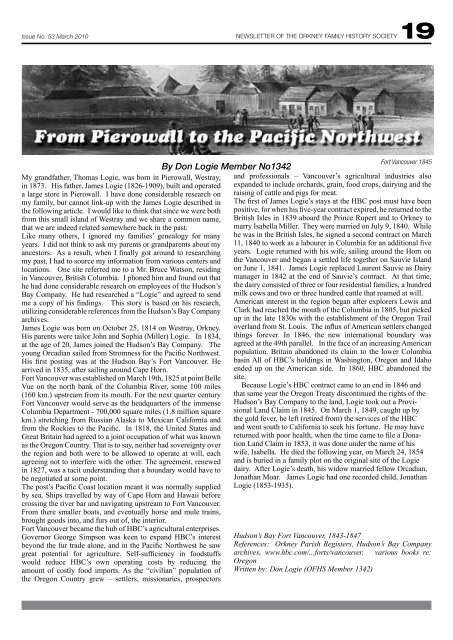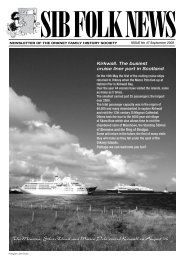The Hamnavoe berthed in Stromness on a fine Spring morning with ...
The Hamnavoe berthed in Stromness on a fine Spring morning with ...
The Hamnavoe berthed in Stromness on a fine Spring morning with ...
You also want an ePaper? Increase the reach of your titles
YUMPU automatically turns print PDFs into web optimized ePapers that Google loves.
Issue No. 53 March 2010 NEWSLETTER OF THE ORKNEY FAMILY HISTORY SOCIETY 19<br />
My grandfather, Thomas Logie, was born <str<strong>on</strong>g>in</str<strong>on</strong>g> Pierowall, Westray,<br />
<str<strong>on</strong>g>in</str<strong>on</strong>g> 1873. His father, James Logie (1826-1909), built and operated<br />
a large store <str<strong>on</strong>g>in</str<strong>on</strong>g> Pierowall. I have d<strong>on</strong>e c<strong>on</strong>siderable research <strong>on</strong><br />
my family, but cannot l<str<strong>on</strong>g>in</str<strong>on</strong>g>k-up <strong>with</strong> the James Logie described <str<strong>on</strong>g>in</str<strong>on</strong>g><br />
the follow<str<strong>on</strong>g>in</str<strong>on</strong>g>g article. I would like to th<str<strong>on</strong>g>in</str<strong>on</strong>g>k that s<str<strong>on</strong>g>in</str<strong>on</strong>g>ce we were both<br />
from this small island of Westray and we share a comm<strong>on</strong> name,<br />
that we are <str<strong>on</strong>g>in</str<strong>on</strong>g>deed related somewhere back <str<strong>on</strong>g>in</str<strong>on</strong>g> the past.<br />
Like many others, I ignored my families’ genealogy for many<br />
years. I did not th<str<strong>on</strong>g>in</str<strong>on</strong>g>k to ask my parents or grandparents about my<br />
ancestors. As a result, when I f<str<strong>on</strong>g>in</str<strong>on</strong>g>ally got around to research<str<strong>on</strong>g>in</str<strong>on</strong>g>g<br />
my past, I had to source my <str<strong>on</strong>g>in</str<strong>on</strong>g>formati<strong>on</strong> from various centers and<br />
locati<strong>on</strong>s. One site referred me to a Mr. Bruce Wats<strong>on</strong>, resid<str<strong>on</strong>g>in</str<strong>on</strong>g>g<br />
<str<strong>on</strong>g>in</str<strong>on</strong>g> Vancouver, British Columbia. I ph<strong>on</strong>ed him and found out that<br />
he had d<strong>on</strong>e c<strong>on</strong>siderable research <strong>on</strong> employees of the Huds<strong>on</strong>’s<br />
Bay Company. He had researched a “Logie” and agreed to send<br />
me a copy of his f<str<strong>on</strong>g>in</str<strong>on</strong>g>d<str<strong>on</strong>g>in</str<strong>on</strong>g>gs. This story is based <strong>on</strong> his research,<br />
utiliz<str<strong>on</strong>g>in</str<strong>on</strong>g>g c<strong>on</strong>siderable references from the Huds<strong>on</strong>’s Bay Company<br />
archives.<br />
James Logie was born <strong>on</strong> October 25, 1814 <strong>on</strong> Westray, Orkney.<br />
His parents were tailor John and Sophia (Miller) Logie. In 1834,<br />
at the age of 20, James jo<str<strong>on</strong>g>in</str<strong>on</strong>g>ed the Huds<strong>on</strong>’s Bay Company. <str<strong>on</strong>g>The</str<strong>on</strong>g><br />
young Orcadian sailed from <str<strong>on</strong>g>Stromness</str<strong>on</strong>g> for the Pacific Northwest.<br />
His first post<str<strong>on</strong>g>in</str<strong>on</strong>g>g was at the Huds<strong>on</strong> Bay’s Fort Vancouver. He<br />
arrived <str<strong>on</strong>g>in</str<strong>on</strong>g> 1835, after sail<str<strong>on</strong>g>in</str<strong>on</strong>g>g around Cape Horn.<br />
Fort Vancouver was established <strong>on</strong> March 19th, 1825 at po<str<strong>on</strong>g>in</str<strong>on</strong>g>t Belle<br />
Vue <strong>on</strong> the north bank of the Columbia River, some 100 miles<br />
(160 km.) upstream from its mouth. For the next quarter century<br />
Fort Vancouver would serve as the headquarters of the immense<br />
Columbia Department - 700,000 square miles (1.8 milli<strong>on</strong> square<br />
km.) stretch<str<strong>on</strong>g>in</str<strong>on</strong>g>g from Russian Alaska to Mexican California and<br />
from the Rockies to the Pacific. In 1818, the United States and<br />
Great Brita<str<strong>on</strong>g>in</str<strong>on</strong>g> had agreed to a jo<str<strong>on</strong>g>in</str<strong>on</strong>g>t occupati<strong>on</strong> of what was known<br />
as the Oreg<strong>on</strong> Country. That is to say, neither had sovereignty over<br />
the regi<strong>on</strong> and both were to be allowed to operate at will, each<br />
agree<str<strong>on</strong>g>in</str<strong>on</strong>g>g not to <str<strong>on</strong>g>in</str<strong>on</strong>g>terfere <strong>with</strong> the other. <str<strong>on</strong>g>The</str<strong>on</strong>g> agreement, renewed<br />
<str<strong>on</strong>g>in</str<strong>on</strong>g> 1827, was a tacit understand<str<strong>on</strong>g>in</str<strong>on</strong>g>g that a boundary would have to<br />
be negotiated at some po<str<strong>on</strong>g>in</str<strong>on</strong>g>t.<br />
<str<strong>on</strong>g>The</str<strong>on</strong>g> post’s Pacific Coast locati<strong>on</strong> meant it was normally supplied<br />
by sea. Ships travelled by way of Cape Horn and Hawaii before<br />
cross<str<strong>on</strong>g>in</str<strong>on</strong>g>g the river bar and navigat<str<strong>on</strong>g>in</str<strong>on</strong>g>g upstream to Fort Vancouver.<br />
From there smaller boats, and eventually horse and mule tra<str<strong>on</strong>g>in</str<strong>on</strong>g>s,<br />
brought goods <str<strong>on</strong>g>in</str<strong>on</strong>g>to, and furs out of, the <str<strong>on</strong>g>in</str<strong>on</strong>g>terior.<br />
Fort Vancouver became the hub of HBC’s agricultural enterprises.<br />
Governor George Simps<strong>on</strong> was keen to expand HBC’s <str<strong>on</strong>g>in</str<strong>on</strong>g>terest<br />
bey<strong>on</strong>d the fur trade al<strong>on</strong>e, and <str<strong>on</strong>g>in</str<strong>on</strong>g> the Pacific Northwest he saw<br />
great potential for agriculture. Self-sufficiency <str<strong>on</strong>g>in</str<strong>on</strong>g> foodstuffs<br />
would reduce HBC’s own operat<str<strong>on</strong>g>in</str<strong>on</strong>g>g costs by reduc<str<strong>on</strong>g>in</str<strong>on</strong>g>g the<br />
amount of costly food imports. As the “civilian” populati<strong>on</strong> of<br />
the Oreg<strong>on</strong> Country grew – settlers, missi<strong>on</strong>aries, prospectors<br />
By D<strong>on</strong> Logie Member No1342<br />
Fort Vancouver 1845<br />
and professi<strong>on</strong>als – Vancouver’s agricultural <str<strong>on</strong>g>in</str<strong>on</strong>g>dustries also<br />
expanded to <str<strong>on</strong>g>in</str<strong>on</strong>g>clude orchards, gra<str<strong>on</strong>g>in</str<strong>on</strong>g>, food crops, dairy<str<strong>on</strong>g>in</str<strong>on</strong>g>g and the<br />
rais<str<strong>on</strong>g>in</str<strong>on</strong>g>g of cattle and pigs for meat.<br />
<str<strong>on</strong>g>The</str<strong>on</strong>g> first of James Logie’s stays at the HBC post must have been<br />
positive, for when his five-year c<strong>on</strong>tract expired, he returned to the<br />
British Isles <str<strong>on</strong>g>in</str<strong>on</strong>g> 1839 aboard the Pr<str<strong>on</strong>g>in</str<strong>on</strong>g>ce Rupert and to Orkney to<br />
marry Isabella Miller. <str<strong>on</strong>g>The</str<strong>on</strong>g>y were married <strong>on</strong> July 9, 1840. While<br />
he was <str<strong>on</strong>g>in</str<strong>on</strong>g> the British Isles, he signed a sec<strong>on</strong>d c<strong>on</strong>tract <strong>on</strong> March<br />
11, 1840 to work as a labourer <str<strong>on</strong>g>in</str<strong>on</strong>g> Columbia for an additi<strong>on</strong>al five<br />
years. Logie returned <strong>with</strong> his wife, sail<str<strong>on</strong>g>in</str<strong>on</strong>g>g around the Horn <strong>on</strong><br />
the Vancouver and began a settled life together <strong>on</strong> Sauvie Island<br />
<strong>on</strong> June 1, 1841. James Logie replaced Laurent Sauvie as Dairy<br />
manager <str<strong>on</strong>g>in</str<strong>on</strong>g> 1842 at the end of Sauvie’s c<strong>on</strong>tract. At that time,<br />
the dairy c<strong>on</strong>sisted of three or four residential families, a hundred<br />
milk cows and two or three hundred cattle that roamed at will.<br />
American <str<strong>on</strong>g>in</str<strong>on</strong>g>terest <str<strong>on</strong>g>in</str<strong>on</strong>g> the regi<strong>on</strong> began after explorers Lewis and<br />
Clark had reached the mouth of the Columbia <str<strong>on</strong>g>in</str<strong>on</strong>g> 1805, but picked<br />
up <str<strong>on</strong>g>in</str<strong>on</strong>g> the late 1830s <strong>with</strong> the establishment of the Oreg<strong>on</strong> Trail<br />
overland from St. Louis. <str<strong>on</strong>g>The</str<strong>on</strong>g> <str<strong>on</strong>g>in</str<strong>on</strong>g>flux of American settlers changed<br />
th<str<strong>on</strong>g>in</str<strong>on</strong>g>gs forever. In 1846, the new <str<strong>on</strong>g>in</str<strong>on</strong>g>ternati<strong>on</strong>al boundary was<br />
agreed at the 49th parallel. In the face of an <str<strong>on</strong>g>in</str<strong>on</strong>g>creas<str<strong>on</strong>g>in</str<strong>on</strong>g>g American<br />
populati<strong>on</strong>. Brita<str<strong>on</strong>g>in</str<strong>on</strong>g> aband<strong>on</strong>ed its claim to the lower Columbia<br />
bas<str<strong>on</strong>g>in</str<strong>on</strong>g> All of HBC’s hold<str<strong>on</strong>g>in</str<strong>on</strong>g>gs <str<strong>on</strong>g>in</str<strong>on</strong>g> Wash<str<strong>on</strong>g>in</str<strong>on</strong>g>gt<strong>on</strong>, Oreg<strong>on</strong> and Idaho<br />
ended up <strong>on</strong> the American side. In 1860, HBC aband<strong>on</strong>ed the<br />
site.<br />
Because Logie’s HBC c<strong>on</strong>tract came to an end <str<strong>on</strong>g>in</str<strong>on</strong>g> 1846 and<br />
that same year the Oreg<strong>on</strong> Treaty disc<strong>on</strong>t<str<strong>on</strong>g>in</str<strong>on</strong>g>ued the rights of the<br />
Huds<strong>on</strong>’s Bay Company to the land, Logie took out a Provisi<strong>on</strong>al<br />
Land Claim <str<strong>on</strong>g>in</str<strong>on</strong>g> 1845. On March 1, 1849, caught up by<br />
the gold fever, he left (retired from) the services of the HBC<br />
and went south to California to seek his fortune. He may have<br />
returned <strong>with</strong> poor health, when the time came to file a D<strong>on</strong>ati<strong>on</strong><br />
Land Claim <str<strong>on</strong>g>in</str<strong>on</strong>g> 1853, it was d<strong>on</strong>e under the name of his<br />
wife, Isabella. He died the follow<str<strong>on</strong>g>in</str<strong>on</strong>g>g year, <strong>on</strong> March 24, 1854<br />
and is buried <str<strong>on</strong>g>in</str<strong>on</strong>g> a family plot <strong>on</strong> the orig<str<strong>on</strong>g>in</str<strong>on</strong>g>al site of the Logie<br />
dairy. After Logie’s death, his widow married fellow Orcadian,<br />
J<strong>on</strong>athan Moar. James Logie had <strong>on</strong>e recorded child, J<strong>on</strong>athan<br />
Logie (1853-1935).<br />
Huds<strong>on</strong>’s Bay Fort Vancouver, 1843-1847<br />
References: Orkney Parish Registers, Huds<strong>on</strong>’s Bay Company<br />
archives, www.hbc.com/...forts/vancouver, various books re:<br />
Oreg<strong>on</strong><br />
Written by: D<strong>on</strong> Logie (OFHS Member 1342)



